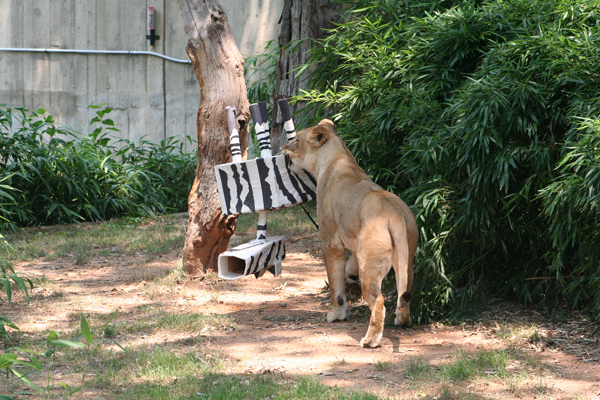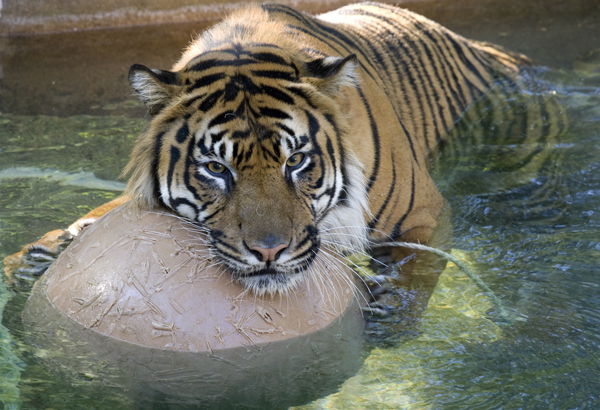Zoos Fake Hunts to Satisfy Predators' Killer Instincts

In the wild, lions and tigers are expert predators that seem to relish the experience of stalking and killing their prey. In zoos, though, animal-on-animal violence is typically forbidden, and there are no savannas or jungles in which to stage a proper hunt anyway. This presents a conundrum. Zookeepers must strive to satisfy their predators' natural urges and dietary needs within their limited confines.
Cold cut meats don't cut the mustard, but neither would a Coliseum-style takedown of antelopes that have nowhere to run. Most zoos strike a happy medium: They combine a carefully designed nutrition plan with simulated hunting experiences.
Well-rounded diet
To keep the big cats' nutrition on par with what they would get in the wild, the Smithsonian National Zoo in Washington feeds its feline residents carcasses once a week. "Carcass feeding is an exciting and tasty way we enrich our carnivores ," Jennifer Zoon, public affairs assistant at the zoo, told Life's Little Mysteries.
The cats don't let a bit go to waste, Zoon explained. "Different parts of a carcass provide different nutrients: The muscle meats are rich in proteins and fats and are a great source of energy. Organs such as the liver provide carnivores with important vitamins, carbohydrates and fiber. Hides, furs and bones provide minerals, such as calcium, and aid in dental care."
Where the National Zoo's lions are concerned, rabbits and cows are the sacrificial lambs. "The zoo receives rabbit carcasses frozen; these are thawed and fed to the lions once a week. During the rest of the week the lions receive a commercially produced diet made of beef, which is supplemented with all the nutrition needed to keep them healthy, plus large femur bones, which they also enjoy chewing on, twice each week," Zoon wrote in an email.
There is some seasonal variation in zoo predators' diets. Last week, when most of the country was swaddled in a heat blanket, zoo animals felt hot like everybody else. According to Today.com, zookeepers at several zoos gave their tigers "bloodsicles" to suck on. Yes, bloodsicles are just what you think they are popsicles of frozen blood. [What Did T. Rex Eat? Grazers? Rotting Meat? Itself? ]
Sign up for the Live Science daily newsletter now
Get the world’s most fascinating discoveries delivered straight to your inbox.
Let them prey
Though a well-rounded diet of bones, organs, meat and blood may satisfy lions' and tigers' nutritional requirements, their psychological health and killer instincts need extra work.
At some zoos, keepers "twitch" the carcasses being served in order to make them look animated.
Other zoos simulate hunts. "We have an enrichment program here that allows our animals to use their natural hunting behaviors without endangering live animals/prey," Zoon wrote. "For example, our lions and tigers are given boomer balls that they can stalk, chase, and pounce on as if they were prey. Our keepers are also very creative and can create 'prey' out of cardboard and other approved materials that our animals may then stalk/hunt."

Watching the animals, they do seem to enjoy these simulated hunting activities.
Do they vaguely sense that they're missing out on the real thing? Who knows? One thing is for sure, though: no matter how many cardboard dummies a lion plays with, it retains its killer instinct. In 2009, a wild deer accidentally hopped into the lion exhibit at the National Zoo. The startled lions quickly took an interest, and chased and swatted at the deer. It escaped, but was so seriously injured that zoo veterinarians had to put it down.
{youtube 7Vf8qCpCaGE}
Fighting back
While some animal-rights advocates may be happy with how benign predator-feeding rituals are at the zoo, others may feel sorry for the predators, whose deepest urges are denied an outlet.
But zookeepers and zoologists point out that hunting is dangerous for predator as well as prey. An injury to a predator often an endangered species during the hunt is a risk its keepers are unwilling to take.
As Andrew Circo of the San Diego Zoo told the British newspaper the Guardian in 2008, "We do not feed live animals for a very important reason. Sometimes those animals fight back and, in exercising their instincts, may injure one of our endangered ... animals. And when dealing with many endangered species, you do not want to take a chance that an injury could lead to other health complications. Not even our snakes get live mice."
- 8 Weird Animal Facts
- Why Don't Tigers Live in Africa?
- Killer Elephants in India: Why They Attack
Follow Natalie Wolchover on Twitter @nattyover. Follow Life's Little Mysteries on Twitter @llmysteries, then join us on Facebook.
Natalie Wolchover was a staff writer for Live Science from 2010 to 2012 and is currently a senior physics writer and editor for Quanta Magazine. She holds a bachelor's degree in physics from Tufts University and has studied physics at the University of California, Berkeley. Along with the staff of Quanta, Wolchover won the 2022 Pulitzer Prize for explanatory writing for her work on the building of the James Webb Space Telescope. Her work has also appeared in the The Best American Science and Nature Writing and The Best Writing on Mathematics, Nature, The New Yorker and Popular Science. She was the 2016 winner of the Evert Clark/Seth Payne Award, an annual prize for young science journalists, as well as the winner of the 2017 Science Communication Award for the American Institute of Physics.











